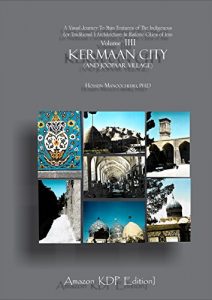Many cities of Iran have a long history of foundation,i.e., from centuries before the Christianity up to the A.D. 10th century. Kermaan City is one of the historic cities of Iran that is located about 1000 miles southeast to Tehran. An Iranian historian, in an article, somehow indirectly refers to Kermaan as the location where the prophet Adam was emerged.
Many features of the traditional ( or the clay or the indigenous) architecture are worth watching in Kermaan City and in other towns in Kermaan. Furthermore, there are many clay castles in Kermaan some of which are built before the A.D. 10th century. The pictorial presentation of the main features of the traditional architecture in Kermaan is divided into 2 volumes: 1) Kermaan City and Joopaar village and 2) Kermaan City and Maahaan Town. Famous features in Kermaan include: many clay castles, many traditional (clay) yakhdaans (ice-reservoirs), many baadgeirs ( wind-catching towers), many maj-moo'ahs ( collection of major public building such as a mosque, a theological school, a ground water reservoir, a public bath, and a baazaar very close together in one section of a city), the traditional baazaar with dome-like roofs by clay, some koochehes (narrow passageways), and the grand Jam'a Mosque of Kermaan in the city center.
Many features of the traditional ( or the clay or the indigenous) architecture are worth watching in Kermaan City and in other towns in Kermaan. Furthermore, there are many clay castles in Kermaan some of which are built before the A.D. 10th century. The pictorial presentation of the main features of the traditional architecture in Kermaan is divided into 2 volumes: 1) Kermaan City and Joopaar village and 2) Kermaan City and Maahaan Town. Famous features in Kermaan include: many clay castles, many traditional (clay) yakhdaans (ice-reservoirs), many baadgeirs ( wind-catching towers), many maj-moo'ahs ( collection of major public building such as a mosque, a theological school, a ground water reservoir, a public bath, and a baazaar very close together in one section of a city), the traditional baazaar with dome-like roofs by clay, some koochehes (narrow passageways), and the grand Jam'a Mosque of Kermaan in the city center.






